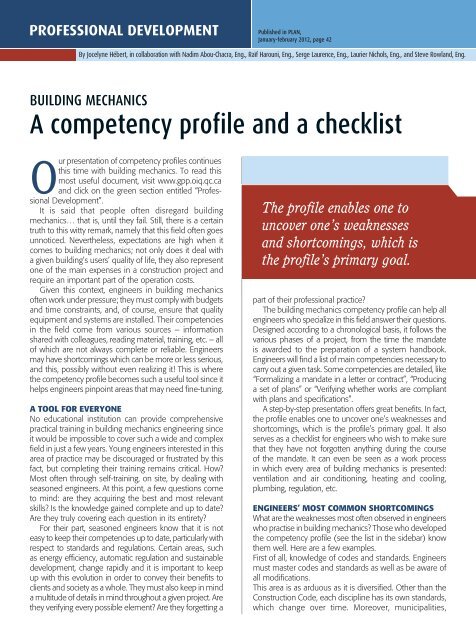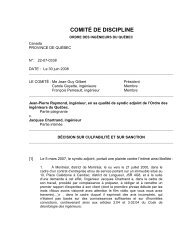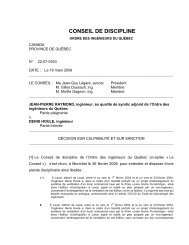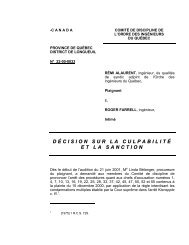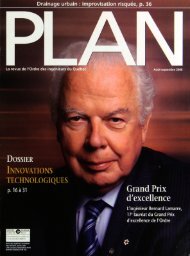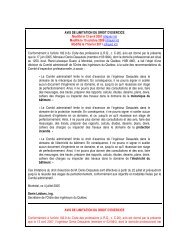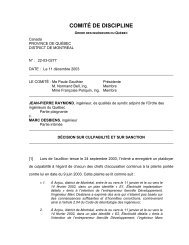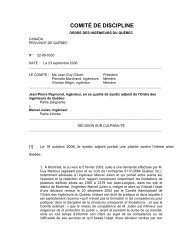a competency profile and a checklist
a competency profile and a checklist
a competency profile and a checklist
You also want an ePaper? Increase the reach of your titles
YUMPU automatically turns print PDFs into web optimized ePapers that Google loves.
Professional development<br />
Published in PLAN,<br />
January-february 2012, page 42<br />
By Jocelyne Hébert, in collaboration with Nadim Abou-Chacra, Eng., Raïf Harouni, Eng., Serge Laurence, Eng., Laurier Nichols, Eng., <strong>and</strong> Steve Rowl<strong>and</strong>, Eng.<br />
Building mechanics<br />
A <strong>competency</strong> <strong>profile</strong> <strong>and</strong> a <strong>checklist</strong><br />
Our presentation of <strong>competency</strong> <strong>profile</strong>s continues<br />
this time with building mechanics. To read this<br />
most useful document, visit www.gpp.oiq.qc.ca<br />
<strong>and</strong> click on the green section entitled “Professional<br />
Development”.<br />
It is said that people often disregard building<br />
mechanics… that is, until they fail. Still, there is a certain<br />
truth to this witty remark, namely that this field often goes<br />
unnoticed. Nevertheless, expectations are high when it<br />
comes to building mechanics; not only does it deal with<br />
a given building’s users’ quality of life, they also represent<br />
one of the main expenses in a construction project <strong>and</strong><br />
require an important part of the operation costs.<br />
Given this context, engineers in building mechanics<br />
often work under pressure; they must comply with budgets<br />
<strong>and</strong> time constraints, <strong>and</strong>, of course, ensure that quality<br />
equipment <strong>and</strong> systems are installed. Their competencies<br />
in the field come from various sources – information<br />
shared with colleagues, reading material, training, etc. – all<br />
of which are not always complete or reliable. Engineers<br />
may have shortcomings which can be more or less serious,<br />
<strong>and</strong> this, possibly without even realizing it! This is where<br />
the <strong>competency</strong> <strong>profile</strong> becomes such a useful tool since it<br />
helps engineers pinpoint areas that may need fine-tuning.<br />
A tool for everyone<br />
No educational institution can provide comprehensive<br />
practical training in building mechanics engineering since<br />
it would be impossible to cover such a wide <strong>and</strong> complex<br />
field in just a few years. Young engineers interested in this<br />
area of practice may be discouraged or frustrated by this<br />
fact, but completing their training remains critical. How?<br />
Most often through self-training, on site, by dealing with<br />
seasoned engineers. At this point, a few questions come<br />
to mind: are they acquiring the best <strong>and</strong> most relevant<br />
skills? Is the knowledge gained complete <strong>and</strong> up to date?<br />
Are they truly covering each question in its entirety?<br />
For their part, seasoned engineers know that it is not<br />
easy to keep their competencies up to date, particularly with<br />
respect to st<strong>and</strong>ards <strong>and</strong> regulations. Certain areas, such<br />
as energy efficiency, automatic regulation <strong>and</strong> sustainable<br />
development, change rapidly <strong>and</strong> it is important to keep<br />
up with this evolution in order to convey their benefits to<br />
clients <strong>and</strong> society as a whole. They must also keep in mind<br />
a multitude of details in mind throughout a given project. Are<br />
they verifying every possible element? Are they forgetting a<br />
The <strong>profile</strong> enables one to<br />
uncover one’s weaknesses<br />
<strong>and</strong> shortcomings, which is<br />
the <strong>profile</strong>’s primary goal.<br />
part of their professional practice?<br />
The building mechanics <strong>competency</strong> <strong>profile</strong> can help all<br />
engineers who specialize in this field answer their questions.<br />
Designed according to a chronological basis, it follows the<br />
various phases of a project, from the time the m<strong>and</strong>ate<br />
is awarded to the preparation of a system h<strong>and</strong>book.<br />
Engineers will find a list of main competencies necessary to<br />
carry out a given task. Some competencies are detailed, like<br />
“Formalizing a m<strong>and</strong>ate in a letter or contract”, “Producing<br />
a set of plans” or “Verifying whether works are compliant<br />
with plans <strong>and</strong> specifications”.<br />
A step-by-step presentation offers great benefits. In fact,<br />
the <strong>profile</strong> enables one to uncover one’s weaknesses <strong>and</strong><br />
shortcomings, which is the <strong>profile</strong>’s primary goal. It also<br />
serves as a <strong>checklist</strong> for engineers who wish to make sure<br />
that they have not forgotten anything during the course<br />
of the m<strong>and</strong>ate. It can even be seen as a work process<br />
in which every area of building mechanics is presented:<br />
ventilation <strong>and</strong> air conditioning, heating <strong>and</strong> cooling,<br />
plumbing, regulation, etc.<br />
Engineers’ most common shortcomings<br />
What are the weaknesses most often observed in engineers<br />
who practise in building mechanics? Those who developed<br />
the <strong>competency</strong> <strong>profile</strong> (see the list in the sidebar) know<br />
them well. Here are a few examples.<br />
First of all, knowledge of codes <strong>and</strong> st<strong>and</strong>ards. Engineers<br />
must master codes <strong>and</strong> st<strong>and</strong>ards as well as be aware of<br />
all modifications.<br />
This area is as arduous as it is diversified. Other than the<br />
Construction Code, each discipline has its own st<strong>and</strong>ards,<br />
which change over time. Moreover, municipalities,
Members of the drafting committee<br />
Competency <strong>profile</strong> in building mechanics<br />
Nadim Abou-Chacra, Eng.<br />
Project Manager, Pageau Morel<br />
Raïf Harouni, Eng.<br />
Consultant in Building Mechanics<br />
Jacques Lagacé, Eng.<br />
Vice President, Innovation <strong>and</strong> Major Projects in Building<br />
Mechanics, Bouthillette Parizeau<br />
Serge Laurence, Eng.<br />
Partner, director Mechanics – Health Sector <strong>and</strong><br />
Special Projects<br />
Leroux Beaudoin Hurens & Associés Inc.<br />
Laurier Nichols, Eng.<br />
Vice President, Building Expertise, Dessau<br />
Stephen A. Rowl<strong>and</strong>, Eng.<br />
Mechanics Consulting<br />
Conrad Tardif, Eng.<br />
Project Manager, CIMA+<br />
other <strong>competency</strong> <strong>profile</strong>s. This reference tool fosters<br />
the professional inspection’s objectivity, st<strong>and</strong>ardizes the<br />
inquiry process <strong>and</strong>, as the case may be, allows engineers<br />
to pinpoint those skills that they must develop or improve.<br />
In short, this unique tool helps many engineers in many<br />
ways. Look it up!<br />
insurance companies <strong>and</strong> a number of other interested<br />
parties can, depending on the m<strong>and</strong>ate, draw on one<br />
version of the Code rather than another, or a specific<br />
variance… By referring to point B2 of the <strong>competency</strong><br />
<strong>profile</strong>s, engineers will be able to see if they are applying<br />
the codes, st<strong>and</strong>ards <strong>and</strong> regulations correctly.<br />
Called upon to concentrate on their design, engineers in<br />
building mechanics must also blend their work with that<br />
of others working in other fields. Mistakes in that respect<br />
can give rise to many others <strong>and</strong> result in unwanted<br />
consequences. Point D11 of the <strong>competency</strong> <strong>profile</strong> spells<br />
out the competencies that engineers must possess in<br />
order to coordinate their design with other stakeholders’<br />
concepts.<br />
Too often, certain engineers in building mechanics rely<br />
on a rule of thumb in cases where scientific <strong>and</strong> accurate<br />
calculations are required.<br />
Without dismissing the usefulness of rules of thumb for<br />
estimations or approximate results, the <strong>competency</strong> <strong>profile</strong><br />
reminds us, at point E, how important it is to base our<br />
calculations on proven methods.<br />
A seamless process<br />
Inspectors at the Ordre’s Professional Inspection<br />
Committee as well as engineers in building mechanics<br />
visited by these inspectors welcome this <strong>competency</strong><br />
<strong>profile</strong> with great satisfaction, as is the case with the


